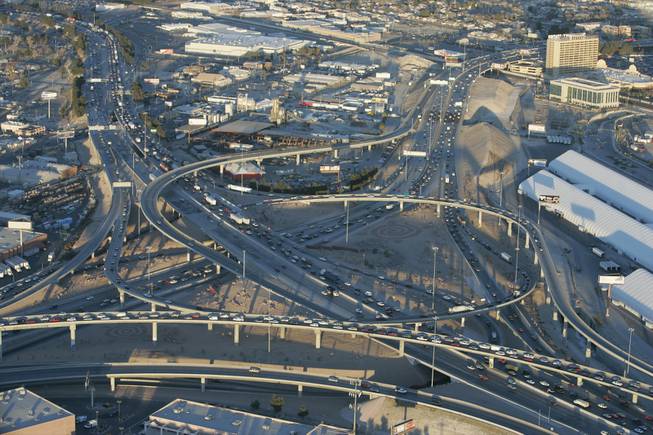
Steve Marcus / Sun File Photo
A view of the Spaghetti Bowl interchange taken from a KLAS-TV helicopter in 2006. The Spaghetti Bowl is where State Route 564, I-215, I-515, U.S Route 93 and U.S Route 95 converge. Las Vegas’ record growth and the ensuing traffic problems created the necessity for interchanges and bypasses like the Spaghetti Bowl.
Published Wednesday, July 8, 2009 | 12:54 a.m.
Updated Wednesday, July 8, 2009 | 5:45 p.m.
Drivers nationwide are spending less time stuck in rush-hour traffic for a second straight year, but in Las Vegas commutes have gotten worse, according to a report released Wednesday.
The average U.S. driver languished in rush-hour traffic for 36.1 hours in 2007, down from 36.6 hours in 2006 and a peak of 37.4 hours in 2005, according to the study by the Texas Transportation Institute. Total wasted fuel also edged lower for the first time, from 2.85 billion gallons in 2006 to 2.81 billion, or roughly three weeks' worth of gas per traveler.
But in Las Vegas, the average annual delay per traveler was 44 hours, tying the region with Baltimore and Riverside-San Bernardino, Calif., for 14th place.
The delays in 2007 for Las Vegas were up one hour from the previous year, but are up 33 hours since 1982, when the records began to be kept.
The report estimates that each traveler in Las Vegas wasted 30 gallons of gas in 2007 and that congestion costs people and businesses $705 million, the 30th highest cost in the country.
Nationally, this is the first two-year decline in congestion as high gas prices and the economic downturn force many Americans to change how they commute.
In other cities, Los Angeles traffic is getting better but is still the worst in the nation. Washington's is getting worse, now ranking second.
The last time traffic congestion had declined was in 1991 amid a spike in oil prices during the first Gulf War.
This time, demographers attributed the decrease to a historic cutback in driving as commuters reduced solo trips, took public transit or carpooled after gas prices surged toward $4 a gallon and then the economy faltered. The housing downturn beginning in 2006 also has played a factor by reducing U.S. migration to far-flung residential exurbs.
But it won't last, assuming the economy recovers.
"Congestion won't be as bad as before for a while, but it will still be very frustrating, very unreliable and it will take a lot of time out of your day," said Tim Lomax, researcher at the Texas Transportation Institute, which is part of Texas A&M University. "The average traveler still needs 25 percent more time for their rush-hour trips."
The Los Angeles metropolitan area, with its car pool lanes and emerging mass transit, shed two hours of wait-time in rush-hour traffic. Still, its sprawling freeway system remained the nation's worst for congestion, with drivers wasting an average of 70 hours in 2007.
The Associated Press contributed to this report.

Join the Discussion:
Check this out for a full explanation of our conversion to the LiveFyre commenting system and instructions on how to sign up for an account.
Full comments policy